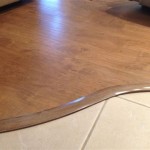Laminate flooring is a popular and affordable way to redecorate a room in your home. It can give a space a fresh look and feel, and is a great alternative to carpet or hardwood floors. Before you start laying your laminate flooring, it’s important to know the best techniques for installing it correctly. This guide will discuss the basics of where to start laminate flooring, so you can get your project off to a successful start.
Steps for Preparing Your Room
Before you start laying your laminate flooring, it’s important to prepare the room. This includes removing any previous flooring, clearing the room of furniture and debris, and making sure the surface is level. It’s also important to check the subfloor for any dips or rises that could affect the installation. If you find these, you may need to fill them in with a self-leveling compound or shim them with plywood.
Inspecting the Laminate Flooring
Once you’ve prepared the room, you’ll need to inspect the laminate flooring before you start laying it. Check that all the pieces are in good condition and that there are no chips or scratches on the surface. It’s also important to make sure the planks fit together properly and that the edges are flush. If any of the planks are damaged, you should replace them.
Determining the Starting Point
When it comes to where to start laminate flooring, the best place is usually in the corner of the room that is farthest from the door. This will give you a good reference point for positioning the planks and will help you create a uniform look. If you’re laying the flooring in a large room, you may want to start in the middle instead. This will help you keep the seams consistent and will make it easier to make any necessary adjustments along the way.
Laying the Laminate Planks
Once you’ve determined where to start laminate flooring, you can begin laying the planks. Start by laying the first two rows in an alternating pattern and make sure that the edges are flush. Use a tapping block and rubber mallet to secure the planks together and make sure that the seams are tight. As you work your way across the room, use spacers to maintain a consistent gap between the planks. This will help to ensure that the flooring is properly installed and will prevent any squeaking or movement.
Finishing Touches
Once you’ve finished laying the planks, use a trimming tool to cut any excess material along the walls. You can also use a flooring saw to cut out any doorjambs or other obstructions. Finally, you’ll need to seal the edges of the flooring with a matching laminate sealant. This will help to keep moisture out and will help to protect your flooring from any damage.
Conclusion
Installing laminate flooring can be a challenging task, but with the right preparation and knowledge, it can be a successful endeavor. By following the steps outlined in this guide, you can determine where to start laminate flooring and ensure that it’s installed properly. With the proper techniques and tools, your laminate flooring will look great and last for years to come.









:max_bytes(150000):strip_icc()/how-to-lay-laminate-flooring-1822250-04-e2971fa6cba84aaabb1bd9d571fbd745.jpg)




:max_bytes(150000):strip_icc()/how-to-lay-laminate-flooring-1822250-01-0b84ff37785a4f8b94ab8bd30c300bfb.jpg)
Related Posts








